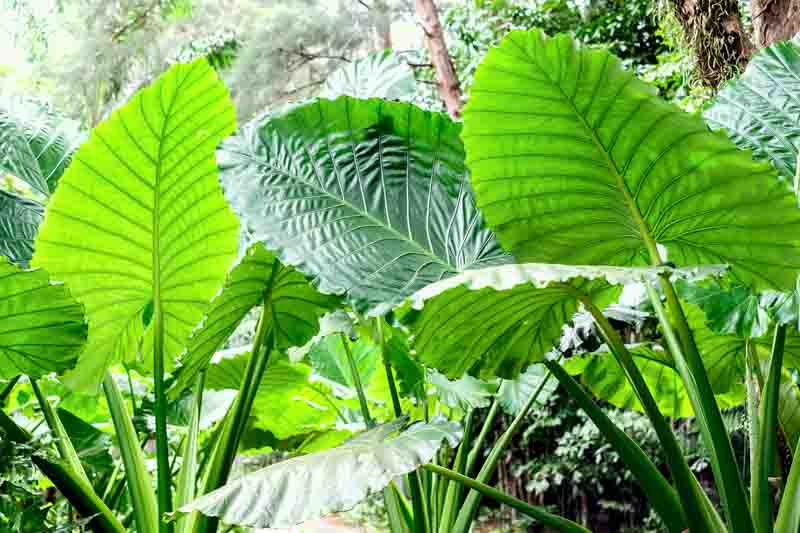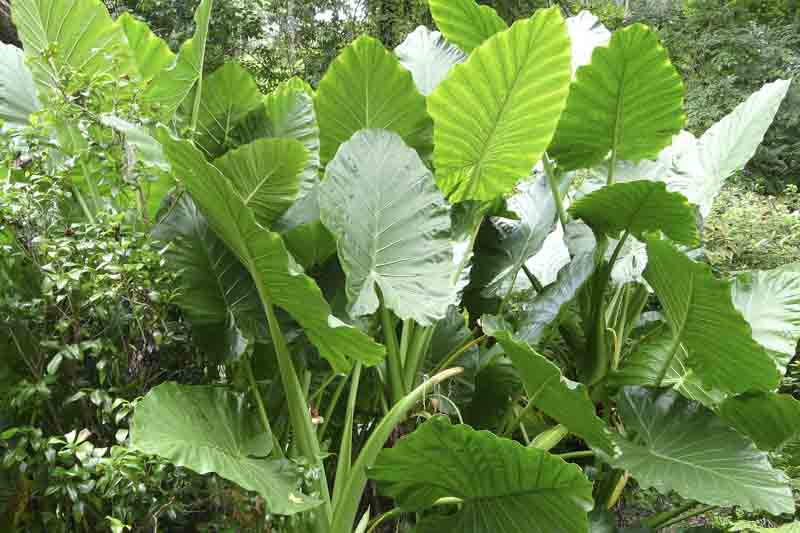Giant Taro, Giant Elephant Ear, Upright Elephant Ear
Alocasia macrorrhizos, commonly known as the Giant Taro or Elephant Ear, is renowned for its strikingly large foliage and robust stature. This plant plays a significant role in both horticultural and cultural contexts across tropical and subtropical regions worldwide.
Alocasia macrorrhizos features immense, glossy, arrow-shaped leaves that can grow 6 feet in length (180 cm). The leaves rise on sturdy, upright stems, creating a dramatic architectural effect. The plant’s overall structure is both majestic and prehistoric in appearance, making it a focal point in any landscape.
Native: Originally native to the rainforests of Southeast Asia and the South Pacific, Alocasia macrorrhizos has been widely cultivated and naturalized in tropical and subtropical climates around the world, including the Caribbean and parts of the Americas. Alocasia odora belongs to the Araceae family, commonly known as the Arum family. This diverse family includes other well-known plants like Zantedeschia (Calla Lily), Caladium (Angel Wing), and Monstera (Swiss Cheese Plant).
Plant Type and Habit: This rhizomatous evergreen perennial plant exhibits an upright, clumping habit. It is a fast-growing species known for reaching considerable heights quickly under optimal conditions.
Size: Giant Taro is one of the larger members of the Alocasia genus, capable of reaching heights of 12 to 15 feet (3.6 to 4.5 meters) and a spread of 6-8 feet (1.8 to 2.4 meters). Its size contributes to its use as a statement plant in landscapes.
Flower: Alocasia macrorrhizos produces a flower spathe, similar to other members of the Araceae family, enveloping a spadix. The flowers are typically greenish-white and can appear throughout the year in tropical climates.
Foliage: The plant’s most distinctive feature is its foliage. Resembling the ears of an elephant, thick, prominently-veined, ruffled, green leaves are borne on rigid stalks (petioles) that jut vertically from a stout upright trunk. Huge, they can reach 3-6 feet in length (90-180 cm) and 2-4 feet in width (60-120 cm). They are arrow-shaped at their bases and stand upright, pointing skyward, unlike the leaves of Colocasia, which droop and point toward the ground.
Hardiness: It is hardy in USDA zones 9-11. It can be grown as an annual or overwintered indoors in cooler climates.
Uses: Beyond its ornamental use in landscapes, Alocasia macrorrhizos has various practical applications. In some cultures, parts of the plant are used for food, although they must be properly processed to remove toxic elements. It also has traditional medicinal uses.
Toxicity: Alocasia plants are toxic if ingested. They contain calcium oxalate crystals that can cause irritation of the mouth, throat, and stomach in humans and pets.
Invasiveness: Alocasia macrorrhizos reproduces through seeds, corms, tubers, and root suckers, thriving in diverse substrates and habitats from full sun to shade. It’s invasive in places like Cuba, New Zealand, and Pacific islands, including Hawaii and Fiji, and considered a weed in Vietnam.

Alocasia macrorrhizos is a striking tropical plant that can make a dramatic statement in any garden or indoor space.
Light: Prefers partial shade but can tolerate full sun if acclimated gradually and provided with sufficient moisture. Indoors, it thrives in bright, indirect light. Avoid direct sunlight, which can scorch the leaves.
Soil: Alocasia macrorrhizos prefers rich, well-draining soil. To improve fertility and drainage, amend garden soil with organic compost. For potted plants, use a peat-based potting mix with perlite or vermiculite.
Water: Keep the soil consistently moist but not waterlogged. Water when the top inch of soil feels dry to the touch. This plant is less tolerant of drought than other Alocasias, so regular watering is important, especially during hot, dry periods.
Temperature and Humidity: Alocasia macrorrhizos does best in warm conditions, ideally between 65°F and 85°F (18°C to 29°C). It is not frost-tolerant and should be protected from cold drafts and temperatures below 50°F (10°C). As a tropical plant, it benefits from high humidity. Indoor plants will appreciate regular misting, placing a humidifier nearby, or using a pebble tray with water to increase the humidity around the plant.
Fertilization: Feed with a balanced, water-soluble fertilizer every 4-6 weeks during the growing season. Reduce feeding in the fall and winter when growth slows.
Pruning: Pruning is generally not necessary except to remove any yellowed or damaged leaves. This helps the plant direct its energy towards new growth and maintains its appearance.
Repotting: Repot every 2-3 years or when the plant becomes root-bound. Choose a pot only slightly larger than the previous one to prevent excessive moisture around the roots.
Overwintering: In regions with cold winters, Alocasia macrorrhizos can be grown in containers and brought indoors or treated as an annual.

Propagating Alocasia macrorrhizos, commonly known as Giant Taro or Upright Elephant Ear, can be done through division, making it relatively straightforward to multiply your plants.
Best Time: The optimal time for propagating Alocasia macrorrhizos is in the spring or early summer, coinciding with the plant’s active growth period. This gives the new plants a full growing season to establish themselves.
Prepare: Water your Alocasia macrorrhizos thoroughly a day before you plan to divide it, as this will make the soil easier to work with and minimize stress to the plant.
Unpot the Plant: Carefully remove the Alocasia from its pot and gently shake off excess soil to reveal the root system and rhizomes.
Identify Division Points: Look for natural divisions in the rhizome where there are separate sections you can divide. Each section should have at least one growing point (shoot or leaf) and a portion of the root system.
Divide the Rhizome: Using your clean, sharp knife or shears, cut the rhizome into sections, ensuring each new division has its own growth point and roots.
Pot Up Divisions: Plant each division in its own pot filled with the appropriate potting mix. Water thoroughly after potting to settle the soil around the roots.
Aftercare: Place the newly potted divisions in a warm, brightly lit area with indirect light. Maintain high humidity around the plants and keep the soil consistently moist but not waterlogged.

Alocasia macrorrhizos is a stunning tropical plant that, while relatively robust, can encounter a few common pests, diseases, and issues, especially when not grown in optimal conditions.
Spider mites: These tiny pests thrive in dry conditions and can cause the leaves to appear speckled and pale, eventually leading to serious damage if not controlled. Regular misting and wiping the leaves can help prevent them.
Mealybugs: These white, fluffy pests feed on the plant sap, weakening the plant. They can be removed with a cotton swab dipped in rubbing alcohol.
Scale insects: These can appear as small brown bumps on the stems and leaves, sucking the sap and reducing plant vigor. Scrape them off or treat them with neem oil.
Aphids: These small, green pests suck sap from new growth. Rinse them off with water or treat the plant with neem oil.
Root rot: Overwatering is a common cause of root rot in Alocasia macrorrhizos. Ensuring well-draining soil and careful watering practices can prevent this issue.
Leaf spot diseases: Fungal or bacterial infections can cause spots on the leaves. Avoid wetting the leaves during watering and improve air circulation around the plant.
Yellowing Leaves: Over- or underwatering can cause leaves to yellow. Adjust your watering schedule to ensure the soil remains moist but not soggy.
Drooping Leaves: This may indicate either a watering issue or insufficient light. Ensure your Alocasia odora receives bright, indirect light and consistent moisture.
Brown Leaf Edges: Low humidity can cause the leaf edges to brown and crisp. Increase humidity around the plant with a humidifier or pebble tray.
| Hardiness |
9 - 11 |
|---|---|
| Heat Zones |
9 - 12 |
| Climate Zones | 22, 23, 24, H1, H2 |
| Plant Type | Houseplants, Perennials |
| Plant Family | Araceae |
| Genus | Alocasia |
| Common names | Giant Elephant Ear |
| Exposure | Partial Sun |
| Season of Interest |
Spring (Early, Mid, Late) Summer (Early, Mid, Late) Fall Winter |
| Height |
12' - 15' (3.7m - 4.6m) |
| Spread |
6' - 8' (180cm - 240cm) |
| Maintenance | Low |
| Water Needs | Average |
| Soil Type | Loam, Sand |
| Soil pH | Acid, Neutral |
| Soil Drainage | Moist but Well-Drained |
| Characteristics | Showy, Evergreen |
| Garden Uses | Beds And Borders, Patio And Containers |
| Garden Styles | Mediterranean Garden |
| Hardiness |
9 - 11 |
|---|---|
| Heat Zones |
9 - 12 |
| Climate Zones | 22, 23, 24, H1, H2 |
| Plant Type | Houseplants, Perennials |
| Plant Family | Araceae |
| Genus | Alocasia |
| Common names | Giant Elephant Ear |
| Exposure | Partial Sun |
| Season of Interest |
Spring (Early, Mid, Late) Summer (Early, Mid, Late) Fall Winter |
| Height |
12' - 15' (3.7m - 4.6m) |
| Spread |
6' - 8' (180cm - 240cm) |
| Maintenance | Low |
| Water Needs | Average |
| Soil Type | Loam, Sand |
| Soil pH | Acid, Neutral |
| Soil Drainage | Moist but Well-Drained |
| Characteristics | Showy, Evergreen |
| Garden Uses | Beds And Borders, Patio And Containers |
| Garden Styles | Mediterranean Garden |
How many Alocasia macrorrhizos (Giant Taro) do I need for my garden?
| Plant | Quantity | |
|---|---|---|
| Alocasia macrorrhizos (Giant Taro) | N/A | Buy Plants |
Create a membership account to save your garden designs and to view them on any device.
Becoming a contributing member of Gardenia is easy and can be done in just a few minutes. If you provide us with your name, email address and the payment of a modest $25 annual membership fee, you will become a full member, enabling you to design and save up to 25 of your garden design ideas.
Join now and start creating your dream garden!
Create a membership account to save your garden designs and to view them on any device.
Becoming a contributing member of Gardenia is easy and can be done in just a few minutes. If you provide us with your name, email address and the payment of a modest $25 annual membership fee, you will become a full member, enabling you to design and save up to 25 of your garden design ideas.
Join now and start creating your dream garden!